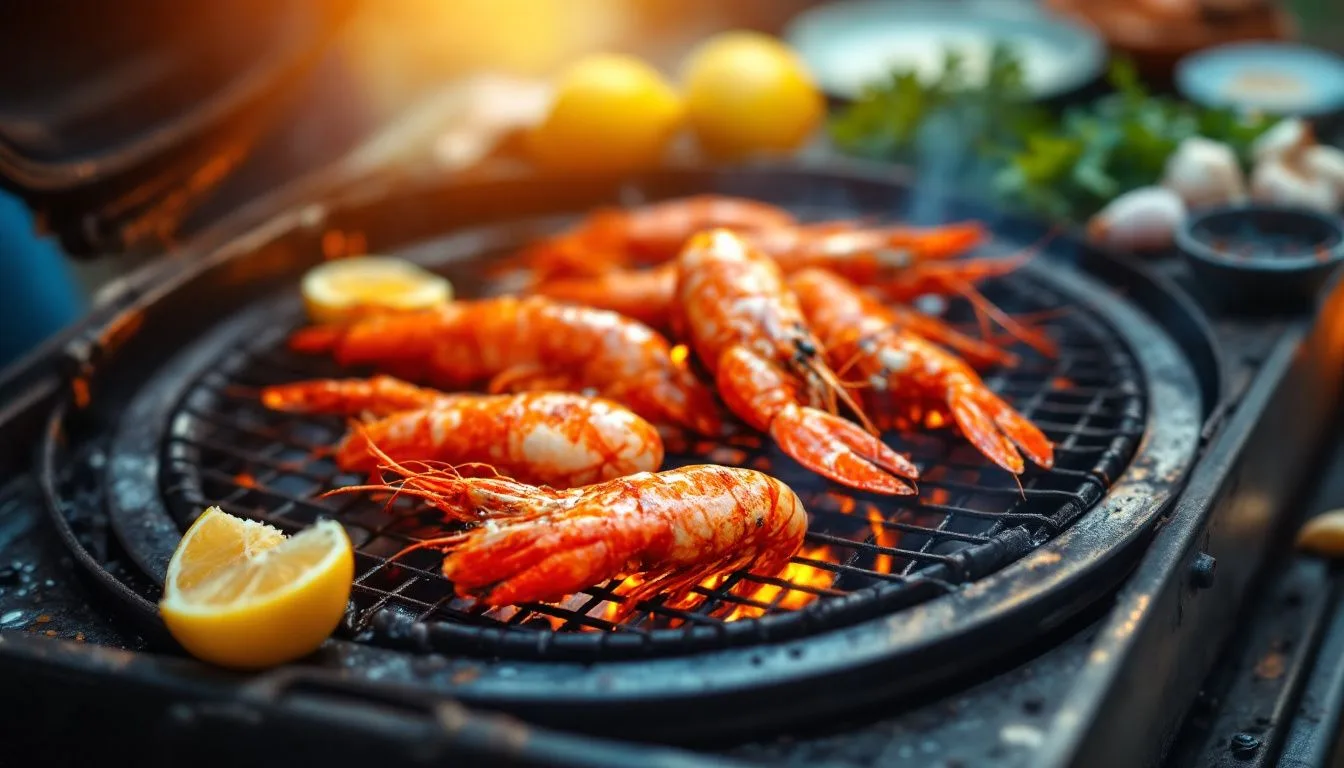Table of Contents
Mastering a langoustine barbecue can be a bit tricky. I understand the challenges all too well from my own experiences. Fortunately, my quest to perfect these dishes has taught me heaps.
In this post, I’ll share top recipes and tips for cooking langoustines. Are you ready to become a pro?
Key Takeaways
- Fresh langoustines make the best barbecue. Look for ones that smell fresh, have firm shells, and a bright colour.
- Preparing langoustines right is important. Clean them, devein, and butterfly before marinating to improve taste.
- Use simple ingredients like garlic, lemon juice, and olive oil for marinades to add flavour.
- Grill langoustines on medium-high heat for about 4-5 minutes each side until they turn pink or orange.
- Experiment with different seasonings such as chilli or fresh herbs to find new favourite recipes.
What are Langoustines?
Langoustines are a type of shellfish. They look like small lobsters and taste delicious.
Types of langoustines
I enjoy learning about different types of langoustines. There are two main species: the European langoustine and the American langoustine. The European one is more popular in Europe, known for its sweet meat.
I often find these at local markets.
Choosing fresh langoustines is key for grilling. Look for ones that smell like the sea and have firm shells. Bright colour usually means they are fresher too. Now that I’ve talked about types, let’s move on to preparing them properly before the barbecue!
How to choose the best langoustines for grilling
Choosing the best langoustines for grilling is very important. I look for fresh ones that feel firm to the touch. Their shells should be shiny and free from dark spots. A bright colour indicates freshness as well.
I check the size too. Bigger langoustines are great for barbecue meals. They hold more flavour and stay juicy on the grill. Finding high-quality seafood ensures a tasty experience, especially in BBQ seafood recipes like grilled langoustines in garlic and parsley marinade.
Next, I’ll share tips on preparing langoustines for grilling.
Tips for Preparing Langoustines
Cleaning and deveining langoustines is simple. You want to remove the shells and any dark veins for a better taste. Butterflying them helps cook evenly. Marinating adds great flavour before grilling.
Cleaning and deveining
I start by cleaning the langoustines. Rinse them under cold water. This helps remove any dirt or sand. Next, I devein them for better taste and texture. I make a shallow cut along the back to expose the vein.
Using a toothpick or knife, I gently pull it out.
Now they are ready for cooking! Keeping the preparation simple enhances their natural flavour. Grilled langoustines taste even better once cleaned and deveined properly.
Butterflying
Butterflying langoustines is a simple process that enhances their flavour. I start by placing the langoustine on a cutting board, belly-side up. Using a sharp knife, I make a long cut down the centre of the shell.
This helps to open it up without cutting all the way through.
Once open, I can season and marinate them easily. Butterflying also allows for even cooking on the grill. The heat reaches more of the meat directly. My barbecued langoustines turn out delicious every time!
Marinating
Preparing langoustines for the grill gets exciting with marinating. I mix olive oil, garlic, lemon juice, and fresh herbs to create a tasty marinade. This blend adds flavour and helps keep the meat moist while grilling.
I let the langoustines soak in the marinade for at least 30 minutes. This step really makes a difference.
Barbecued langoustines benefit from bold flavours. Chilli can add heat if that’s your style. A dash of salt and pepper enhances the taste too. Using different marinades gives me new ways to enjoy my meals every time I fire up the BBQ!
Top BBQ Recipes for Langoustines
I have some great BBQ recipes for langoustines. Each recipe is simple and packed with flavour, making them perfect for your next cookout.
Grilled langoustines in garlic and parsley marinade
Grilled langoustines in garlic and parsley marinade are a delight. I mix chopped garlic and fresh parsley with olive oil. This simple blend adds great flavour to the langoustines. After cleaning them, I coat the shellfish well in the marinade.
I let them marinate for about 30 minutes. This allows the flavours to soak in nicely. On the grill, they cook quickly, usually around 5-7 minutes per side. The result? Tender and tasty barbecued langoustines that shine on any seafood barbecue table!
Barbecued langoustines with aioli
I love barbecued langoustines with aioli. This dish is simple yet so tasty. First, I prepare the langoustines by cleaning and deveining them. Then, I marinate them in a mix of garlic, lemon juice, and olive oil for about thirty minutes.
Once they are ready, I place the langoustines on the grill over medium heat. The key is to cook them for just a few minutes on each side until they turn pink and opaque. While grilling, I whip up some homemade aioli using egg yolks, mustard, lemon juice, and olive oil.
This creamy dip pairs perfectly with the smoky flavour of barbecued langoustines. Enjoying this meal always brings a smile to my face!
BBQ langoustines with chilli and lemon
BBQ langoustines with chilli and lemon are a treat. I start by mixing fresh lemon juice, olive oil, and chopped chillies for the marinade. This mix adds heat and brightness to the sweet langoustines.
Next, I coat the cleaned langoustines in this mixture. Let them sit so they absorb all those tasty flavours.
Grilling is simple yet rewarding. The key is to cook on high heat for just a few minutes per side. This method gives them a nice char without drying them out. The result is succulent seafood with a zesty kick that shines through every bite.
Cooking over flames makes it even better! Langoustine lovers will enjoy this dish at any barbecue gathering.
Mastering the BBQ Technique
Mastering the BBQ technique is essential for perfect langoustines. I focus on proper grilling methods. Getting the seasoning right adds great flavour. Cooking times matter too; don’t overcook!
Want to learn more? Read on!
Proper grilling techniques
Grilling langoustines is a joy. I focus on heat and timing. Preheat the grill to a medium-high temperature. This ensures the langoustines cook evenly. Place them shell-side down first for about three minutes.
I like to turn them after that, cooking for another two to three minutes. Keeping an eye on colour helps too; they should become bright orange or pink when done. Using a meat thermometer can also help me check if they reach 70°C in the thickest part of the tail.
For extra flavour, I brush them with oil or my favourite marinade while grilling.
Seasoning and flavor profiles for langoustines
Proper grilling techniques set the stage for great taste. Seasoning is key to bringing out the best in langoustines. I love using simple ingredients like garlic, lemon, and fresh herbs.
They really enhance the natural sweetness of the meat.
Langoustine dishes shine with a touch of spice too. A bit of chilli can add warmth without overpowering. Sea salt brightens up their flavour profile nicely. Experimenting with different seasonings helps me discover new favourite langoustine recipes.
Each bite becomes special on my barbecue table.
Cooking times and temperature
Cooking langoustines requires attention to time and temperature. I usually grill them for about 4 to 5 minutes on each side. The heat should be medium-high, around 200°C (400°F).
This helps to cook the seafood evenly without burning it.
I check for doneness by looking at the colour. Langoustines turn pink when they are cooked well. Their meat should also feel firm and opaque. I suggest using a meat thermometer; the internal temperature should reach about 60°C (140°F).
By mastering cooking times and temperatures, my barbecued langoustine dishes always impress!
Conclusion
In conclusion, barbecuing langoustines can be a delightful experience. With the right skills and recipes, you can create amazing dishes that impress everyone.
How to take your barbecued langoustines to the next level
To take my barbecued langoustines to the next level, I focus on seasoning. Langoustines have a delicate taste. A good marinade really brings out their flavour. I love using garlic, lemon, and fresh herbs.
Marinating for at least 30 minutes makes a big difference.
Cooking technique is also key. I grill them over medium heat to avoid drying them out. Keeping an eye on the timing helps too; around 5-7 minutes per side usually works well. Drizzling some langoustine head oil can add extra richness that enhances each bite of barbecue langoustines.
Advice for seafood lovers
After exploring how to take your barbecued langoustines to the next level, I want to share some advice for seafood lovers. Freshness is key. Always look for live langoustines when possible.
Their shells should be firm, and they should feel heavy. I find that good seafood markets often have the best options.
Preparation matters too. Clean and devein your langoustines properly to avoid any grit. Marinating them adds great flavour. I love using garlic and lemon juice combined with herbs for a tasty kick! Barbecue tips are critical here as well; maintain a steady heat for perfect cooking times and temperature control.
Grilling langoustines can be simple but rewarding with these techniques in mind!
FAQs
1. What is the art of mastering langoustine barbecue?
Mastering the art of langoustine barbecue involves learning different cooking methods and techniques, understanding its flavor profile, and knowing how to season it perfectly for a delicious barbecued seafood dish.
2. How can one prepare langoustines for a barbecue?
Langoustine preparation methods for a barbecue include cleaning them properly, seasoning them with your preferred spices, and using specific cooking techniques like grilling the tail or making barbecued head oil.
3. Can you share some top recipes for Langoustine Barbecue?
Yes, there are numerous recipe ideas available that showcase various ways to cook this delicacy on the grill – from simple grilled tails to more complex dishes involving barbecued head oil.
4. What culinary skills are required in mastering langoustine barbecue?
Key culinary skills needed include understanding the unique flavour profile of Langoustines, mastery over preparation methods including correct cleaning and seasoning processes; as well as expertise in applying appropriate cooking techniques such as proper grilling time on a BBQ.
5. Why should I try my hand at Langoustine Barbecue Mastery?
Barbecuing langoustines provides an opportunity to explore diverse seafood flavours while honing your culinary skills; plus it’s an excellent way to impress guests at your next outdoor gathering!

